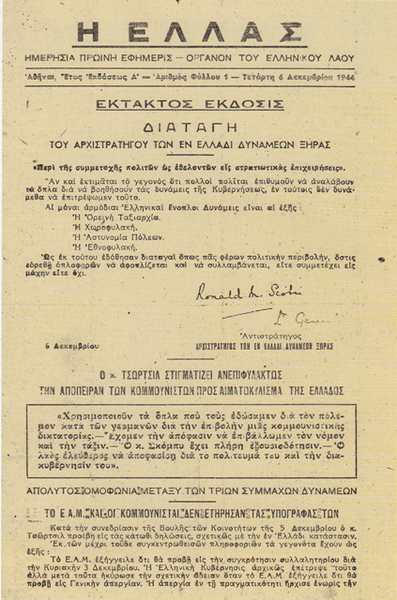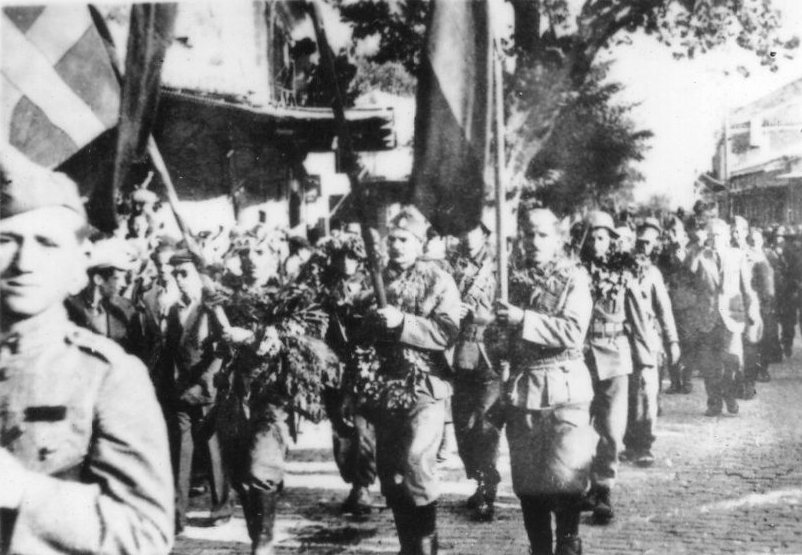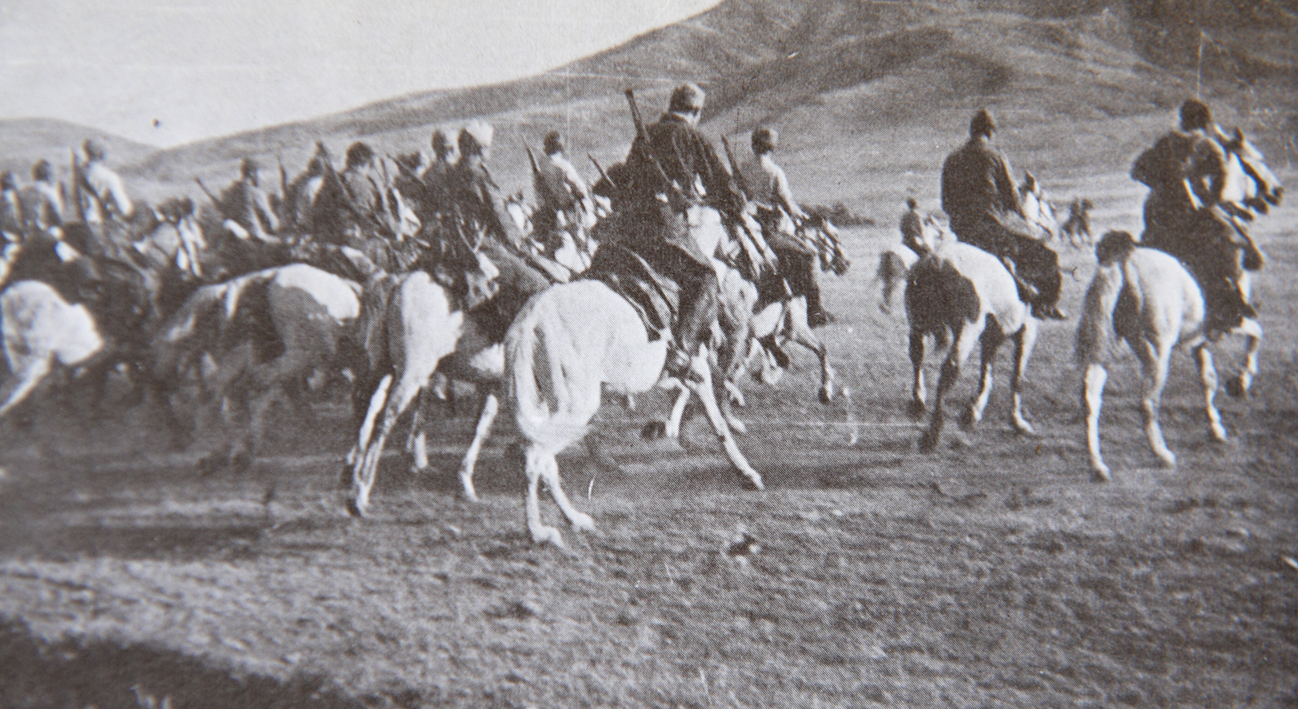|
ELAS
The Greek People's Liberation Army ( el, Ελληνικός Λαϊκός Απελευθερωτικός Στρατός (ΕΛΑΣ), ''Ellinikós Laïkós Apeleftherotikós Stratós'' (ELAS) was the military arm of the left-wing National Liberation Front (EAM) during the period of the Greek resistance until February 1945, when, following the ''Dekemvriana'' clashes and the Varkiza Agreement, it was disarmed and disbanded. ELAS was the largest and most significant of the military organizations of the Greek resistance. Birth of ELAS After Nazi Germany attacked the Soviet Union with the initiation of Operation Barbarossa (June 22, 1941) — with most of Greece having fallen under Axis occupation since April and the Battle of Crete having ended on June 1 — the Greek Communist Party (KKE) called for national resistance. The KKE, together with minor parties of the Left, formed a political structure called the National Liberation Front. They were joined by other center-left or ... [...More Info...] [...Related Items...] OR: [Wikipedia] [Google] [Baidu] |
Dekemvriana
The ''Dekemvriana'' ( el, Δεκεμβριανά, "December events") refers to a series of clashes fought during World War II in Athens from 3 December 1944 to 11 January 1945. The conflict was the culmination of months of tension between the communist EAM, some parts of its military wing, the ELAS stationed in Athens, the KKE and the OPLA from one side and from the other side, the , some parts of the Hellenic Royal Army, the Hellenic Gendarmerie, the Cities Police, the far-right Organization X, among others and also the British Army. Regardless of the tensions between the left and the right, in May 1944 it had been roughly agreed in the Lebanon Conference that all non-collaborationist factions would participate in a Government of National Unity; eventually 6 out of 24 ministers were appointed by EAM. Additionally, a few weeks before the withdrawal of the German troops in October 1944, it had been reaffirmed in the Caserta Agreement that all collaborationist forces would ... [...More Info...] [...Related Items...] OR: [Wikipedia] [Google] [Baidu] |
National Liberation Front (Greece)
The National Liberation Front ( el, Εθνικό Απελευθερωτικό Μέτωπο, ''Ethnikó Apeleftherotikó Métopo'' (EAM) was an alliance of various political parties and organizations which fought to liberate Greece from Axis Occupation. It was the main movement of the Greek Resistance during the occupation of Greece. Its main driving force was the Communist Party of Greece (KKE), but its membership throughout the occupation included several other leftist and republican groups. ΕΑΜ became the first true mass social movement in modern Greek history. Its military wing, the Greek People's Liberation Army (ELAS), quickly grew into the largest armed guerrilla force in the country, and the only one with nationwide presence. At the same time, from late 1943 onwards, the political enmity between ΕΑΜ and rival resistance groups from the centre and right evolved into a virtual civil war, while its relationship with the British and the British-backed Greek governmen ... [...More Info...] [...Related Items...] OR: [Wikipedia] [Google] [Baidu] |
National Groups Of Greek Guerrillas
The National Republican Greek League ( el, Εθνικός Δημοκρατικός Ελληνικός Σύνδεσμος (ΕΔΕΣ), ''Ethnikós Dimokratikós Ellinikós Sýndesmos'' (EDES)) was one of the major resistance groups formed during the Axis occupation of Greece during World War II. The largest of the non-communist resistance groups, its military wing, the National Groups of Greek Guerrillas (Εθνικές Ομάδες Ελλήνων Ανταρτών, ''Ethnikés Omádes Ellínon Antartón'' (ΕΟΕΑ)) concentrated its military activities in Epirus. From 1943 onwards, EDES came into confrontation with the communist-led National Liberation Front, beginning a series of civil conflicts that would lead to the Greek Civil War. Foundation and ideology The National Republican Greek League was founded on 9 September 1941 by a former army officer, Colonel Napoleon Zervas, a centrist who had been expelled from the army after the failed pro-Venizelist coup d'état of 19 ... [...More Info...] [...Related Items...] OR: [Wikipedia] [Google] [Baidu] |
EDES
The National Republican Greek League ( el, Εθνικός Δημοκρατικός Ελληνικός Σύνδεσμος (ΕΔΕΣ), ''Ethnikós Dimokratikós Ellinikós Sýndesmos'' (EDES)) was one of the major resistance groups formed during the Axis occupation of Greece during World War II. The largest of the non-communist resistance groups, its military wing, the National Groups of Greek Guerrillas (Εθνικές Ομάδες Ελλήνων Ανταρτών, ''Ethnikés Omádes Ellínon Antartón'' (ΕΟΕΑ)) concentrated its military activities in Epirus. From 1943 onwards, EDES came into confrontation with the communist-led National Liberation Front, beginning a series of civil conflicts that would lead to the Greek Civil War. Foundation and ideology The National Republican Greek League was founded on 9 September 1941 by a former army officer, Colonel Napoleon Zervas, a centrist who had been expelled from the army after the failed pro-Venizelist coup d'état of 19 ... [...More Info...] [...Related Items...] OR: [Wikipedia] [Google] [Baidu] |
Panhellenic Liberation Organization
The Panhellenic Liberation Organization ( el, Πανελλήνιος Απελευθερωτική Οργάνωσις (ΠΑΟ), ''Panellinios Apeleftherotiki Organosis'' (PAO)), was a Greek resistance organization against the Axis occupation of Greece. It was founded in 1941 by a group of Greek army officers, under the name Defenders of Northern Greece (Υπερασπισταί Βορείου Ελλάδος, YBE; ''Yperaspistai Voreiou Ellados'', ''YVE''), employing methods of non violent resistance. In 1943, YVE was renamed as the Panhellenic Liberation Organization (PAO), shifting its focus towards armed struggle. In the August of the same year it came into conflict with Greek People's Liberation Army (ELAS), a communist-led resistance organization. PAO was defeated in the ensuing civil war and its remnants turned towards collaboration with the Germans. Background On 28 October 1940, Italy declared war on Greece, expecting a swift victory but the invasion failed and the Italians ... [...More Info...] [...Related Items...] OR: [Wikipedia] [Google] [Baidu] |
Aris Velouchiotis
Athanasios Klaras ( el, Αθανάσιος Κλάρας; August 27, 1905 – June 15, 1945), better known by the ''nom de guerre'' Aris Velouchiotis ( el, Άρης Βελουχιώτης), was a Greek journalist, politician, member of the Communist Party of Greece, the most prominent leader and chief instigator of the Greek People's Liberation Army (ELAS) and the military branch of the National Liberation Front (EAM), which was the major resistance organization in occupied Greece from 1942 to 1945. Early years Aris Velouchiotis was born in Lamia, Greece in 1905, to an upper urban class family. His father was Dimitrios Klaras, a well-known lawyer in the area and his mother was Aglaia Zerva. Initially Klaras studied journalism, but later attended and graduated from the Geoponic School of Larissa. He left for Athens, where he did various jobs, participated in the leftist and antimilitary movement and later became a member of the Communist Party of Greece (KKE). During the 1920 ... [...More Info...] [...Related Items...] OR: [Wikipedia] [Google] [Baidu] |
Security Battalions
The Security Battalions ( el, Τάγματα Ασφαλείας, Tagmata Asfaleias, derisively known as ''Germanotsoliades'' (Γερμανοτσολιάδες) or ''Tagmatasfalites'' (Ταγματασφαλίτες)) were Greek collaborationist military groups, formed during the Axis occupation of Greece during World War II in order to support the German occupation troops. History The Battalions were founded in 1943 by the government of Ioannis Rallis. The Rallis cabinet passed the law raising the Security Battalions on 7 April 1943. The driving force behind raising the Security Battalions was the former dictator, General Theodoros Pangalos, who saw the Security Battalions as his means of making a political comeback, and most of the Hellenic Army officers recruited into the Security Battalions in April 1943 were republicans who were in some way associated with Pangalos. The National Schism between royalists and republicans was still going strong in the 1940s, and there we ... [...More Info...] [...Related Items...] OR: [Wikipedia] [Google] [Baidu] |
Slavic-Macedonian National Liberation Front
The National Liberation Front ( mk, Народноослободителен фронт (НОФ), ''Narodnoosloboditelen front'' (NOF)), also known as the People's Liberation Front, was a communist political and military organization created by the Slavic Macedonian minority in Greece. The organization operated from 1945–1949, most prominently in the Greek Civil War. As far as its ruling cadres were concerned its participation in the Greek Civil War was nationalist rather than communist, with the goal of secession from Greece. Background Historical overview Late Ottoman era The 'Macedonian Question' surfaced in 1878, after the Treaty of Berlin had revised the short-lived ' Greater Bulgaria' established by the Treaty of San Stefano and turned back Macedonia under Ottoman control. During rise of nationalism in the Ottoman Empire, the Slavic speakers in Ottoman Macedonia were under the influence of the Bulgarian, Greek and Serbian religious, educational and military propa ... [...More Info...] [...Related Items...] OR: [Wikipedia] [Google] [Baidu] |
National Liberation Front (Macedonia)
The National Liberation Front ( mk, Народноослободителен фронт (НОФ), ''Narodnoosloboditelen front'' (NOF)), also known as the People's Liberation Front, was a communist political and military organization created by the Slavic Macedonian minority in Greece. The organization operated from 1945–1949, most prominently in the Greek Civil War. As far as its ruling cadres were concerned its participation in the Greek Civil War was nationalist rather than communist, with the goal of secession from Greece. Background Historical overview Late Ottoman era The 'Macedonian Question' surfaced in 1878, after the Treaty of Berlin had revised the short-lived 'Greater Bulgaria' established by the Treaty of San Stefano and turned back Macedonia under Ottoman control. During rise of nationalism in the Ottoman Empire, the Slavic speakers in Ottoman Macedonia were under the influence of the Bulgarian, Greek and Serbian religious, educational and military propagan ... [...More Info...] [...Related Items...] OR: [Wikipedia] [Google] [Baidu] |
Organization X
The Organization ''X'' ( el, Οργάνωσις Χ; commonly referred to simply as ''X'' (" Chi" in Greek), and members as Chites (Χίτες)) was a paramilitary right-wing anti-communist royalist organization set up in 1941 during the Axis occupation of Greece. Initially an anti-Axis resistance organization, it gradually shifted its focus towards anti-communism. In 1951, ''X'' was officially recognized as a ''National Organization of Internal Resistance'' by the Greek Ministry of National Defense. Following the end of the Axis occupation, it played an active role in the persecution of communists during the White Terror and various military operations of the Greek Civil War, most notably the Dekemvriana. Foundation and activities during the Occupation Organization ''X'' was founded in 1941 by General Georgios Lavdas with Colonel Georgios Grivas acting as his chief of staff. Lavdas soon came into conflict with other members of the group because of his radical monarchist ... [...More Info...] [...Related Items...] OR: [Wikipedia] [Google] [Baidu] |
National And Social Liberation
National and Social Liberation (, ''Ethnikí kai Koinonikí Apelefthérosis'' (EKKA)) was a Greek Resistance movement during the Axis occupation of Greece. It was founded in autumn 1942 by Colonel Dimitrios Psarros and politician Georgios Kartalis. History Alongside Psarros and Kartalis, founding members included fellow officers Dimitrios Karachristos, Dimitrios Georgantas and others. The organization's aims were to fight the Germans as long as the occupation lasted and, after Liberation, work for a republican regime and social change. EKKA's armed wing was the 5/42 Evzone Regiment, founded in early 1943 and named after Psarros' old army unit. It numbered at its peak ca. 1,000 men, and was active mainly in Central Greece, in the area of Phocis. The organization however was from the outset confronted with the might of the communist-led Greek People's Liberation Army (ELAS), which claimed the overall leadership of the Resistance movement and regarded EKKA as reactionary an ... [...More Info...] [...Related Items...] OR: [Wikipedia] [Google] [Baidu] |
Stefanos Sarafis
Stefanos Sarafis ( el, Στέφανος Σαράφης, 23 October 1890 – 31 May 1957) was an officer of the Hellenic Army and Major General in EAM-ELAS), who played an important role during the Greek Resistance. Early life and career Sarafis was born at Trikala in 1890. He was an Aromanian. Sarafis studied law in the University of Athens. During the Balkan Wars, he enlisted in the Greek Army as a sergeant and was promoted to lieutenant in 1913. He became a Venizelist and played an active role in the various military conspiracies that were formed during the troubled 1920s. He participated in the two failed Venizelist coup attempts of 1933 and 1935. The latter was led by Nikolaos Plastiras and intended to overthrow the government of Prime Minister Panagis Tsaldaris. The failure of the coup resulted in the execution of its leader for treason and dishonorable discharges for several of the participants. Sarafis himself was condemned to life imprisonment but was pardoned by the ... [...More Info...] [...Related Items...] OR: [Wikipedia] [Google] [Baidu] |





